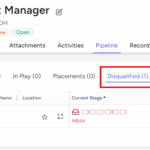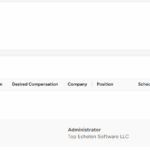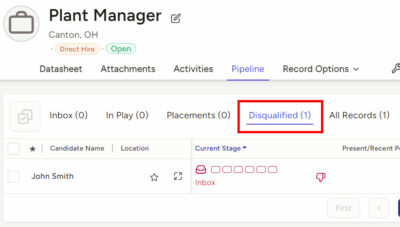It doesn’t matter how good of a recruiter you are. If you’re working with a client that has a poor hiring process, then your chances of making a successful placement just went down.
Unfortunately, there are plenty of great recruiters out there who are working with clients that have a poor hiring process. Heck, you might be one of them.
So . . . these recruiters (which might include you) have a choice:
- Fire the client.
- Manage the placement process in such a way that you’re able to overcome the deficiencies of the client’s hiring process.
The placement process: a definition
Before we go further, let’s get something out of the way. There are all sorts of definitions floating around on the Internet regarding the placement process (which is also called the employee placement process and the job placement process). There are those who believe that placement sometimes involves existing employees, as opposed to new ones. While that might make sense in select workforce management situations, it does not suit our needs for this particular blog post.
That’s because for this particular blog post, we’re addressing the topic from the point of view of the recruiter. Specifically, we’re addressing it from the point of view of the third-party agency recruiter. As you might imagine, the steps involved for them are slightly different then the steps involved for a hiring manager or other employee of an organization.
So, with all of that being said, the placement process (or employee placement process or job placement process) is the process by which a recruiter helps a client fill one of its open positions through the successful matching of the job’s requirements to what a potential candidate offers in the form of skills, experience, and other qualifications.
So . . . where were we? Oh, yes . . .
It’s tempting to just fire the client when they have a pre-existing and low quality recruitment, selection, and placement process, isn’t it? Until you count how many placements you’ve made with that client. Perhaps they had a great process at one point. Maybe the hiring manager with whom you’ve always dealt has moved on and they’ve been replaced by somebody you’d really like to slap. (Admit it, you’ve thought about it.)
As a recruiter, you know full well that an organization’s biggest obstacle to hiring top talent is the organization itself. It can’t get out of its own way. That’s partly why they’ve hired you. But even with your professional help and expert assistance, the organization sometimes can’t get out of its own way.
That’s why for some of your clients, you must troubleshoot the whole placement process up front. You must make a proactive effort to manage the process from start to finish. This helps ensure that you’re not the victim of some “nasty surprise” at some point.
Troubleshooting the employee placement process
With all of that in mind, below are seven steps for more effectively managing the job placement process:
#1 — Qualify the job order.
Okay, we’ve harped on this one time and again. However, that underscores its importance. In fact, we published a blog post titled, “The Single Most Important Key to Making More Placements.” That key? Quality job orders. There are a number of things that recruiters should do during this step, but a few of those things are as follows:
- The details of the job description, especially the “sizzle”
- The specific characteristics that a candidate would need to possess for the company to extend an offer
- Whether or not your client is considering internal candidates (isn’t that always a nice last-minute surprise?)
- If it’s not an exclusive search assignment, how many other search firms the company is using
You have to ascertain whether or not the search is worth your time. This information is crucial to making that determination. We’ll assume you want to work the search, so on to the next step of the job placement process . . .
#2 — Set actual dates when discussing the hiring specifics.
This step is tied directly to urgency. Because even if you’ve qualified the job order, you’re in for a rough ride if there is no urgency tied to the job order. How do you determine the level of urgency involved with a search? With specifics, as opposed to generalities.
There are two areas where you need to secure specific pieces of information. Those areas both involve dates.
- The date that the client wants to start the interviewing stage.
- The drop-dead date that the client wants the position to be filled.
In order to secure these dates, you must ask the right questions. And as you might imagine, when you ask these questions, you must be specific. Those questions include the following:
- “On what date do you want to start having face-to-face interviews?”
- “By what date do you want to have somebody on board?”
Answers like “ASAP” are bogus. That’s because there is no set timetable. You can’t work backwards from “ASAP” to create a timeline of predicated upon urgency. The conclusion? It’s a worthless answer, and the selection and placement process will probably be drawn out.
#3 — Work directly with the hiring manager.
Yes, this one is definitely easier said than done. At one point in your career, you might have worked with the hiring manager of every single one of your clients. These days, it’s becoming less and less the case. The reason you want to work with the hiring manager, of course, is that they are the people who are feeling the pain of leaving the positions open. Or at the very least, they’re also feeling the pain of keeping the position open. Consequently, they’re more likely to act with a sense of urgency.
In recent years, all sorts of obstacles and roadblocks have been thrown in front of what, up until now, has been a very workable arrangement. Some organizations have mandated that everything go through HR—even you, the recruiter who has worked with them for years. While it might be more difficult to do so these days, working directly with the hiring manager is imperative for effective management of the employee placement process.
#4 — Set concrete expectations for the search up front.
We’re talking about setting expectations for as many things as you can—the date of the first round of interviews, the drop-dead date when the company wants somebody in the position, the protocol for providing feedback, the acknowledged methods of communication, etc. You must discuss and agree upon all of this prior to the start of the search. If that doesn’t happen, then you’re just asking for a “world of hurt.” Not only that, #6 on our list won’t be even possible.
#5 — Educate the client about current market conditions.
This is a candidates’ market. It’s been a candidates’ market for quite some time. Unfortunately, there are some organizations that do not fully realize what that means. Specifically, they don’t realize the following:
- They must convince passive A-level candidates have to consider their open position. (This is where you, the recruiter, comes in.)
- These types of candidates, once in a job search, are usually interviewing with more than one company.
- As a result, some of these candidates can expect to receive offers of employment from more than one company.
- These candidates are NOT going to stay in an organization’s recruiting and hiring process forever, with no feedback and no idea of where they stand.
With all of this in mind, the client should understand that a really good candidate is not going to stay in a hiring process that exceeds four weeks. They will be gone by that time, and hiring managers must understand this and act accordingly. If they don’t, it will be that much more difficult for you to manage the placement process.
#6 — Tie the hiring manager’s actions (and inactions) back to the stated expectations.
If something goes awry during the employee placement process and that something is the fault of the hiring manager, then you must be prepared to hold that hiring manager accountable for their actions (or their inactions). This is what I was talking about back in #4. You set concrete expectations before the process starts so that you can hold hiring authorities accountable for those expectations once the process has begun. If a hiring manager does not want to agree to concrete expectations, that means they don’t want to be held accountable for anything. And if they don’t want to be held accountable for anything, do you really want to work with them on this search?
#7 — Make sure that YOU are the one extending the offer.
Candidates, especially top candidates, expect their recruiter to be the one who extends the offer. They’re more comfortable with that. Why? Because they can discuss the terms of the offer with their recruiter and ask questions they would not be comfortable asking the hiring authority. But really, that’s not enough to convince the hiring manager that you should be the one making the offer. As usual, you must illustrate why it is in their best interests for you to do so.
As a recruiter, there are ways to set yourself up more for success. Managing the job placement process more effectively is one of those ways. Can you control candidates? Can you control clients? No and no.
However, you CAN put yourself in the best position possible to ensure a placement of one of your candidates, and more importantly, ensure the fee that goes along with that placement.
Top Echelon offers a free monthly webinar as part of its Recruiter Coaching Series. After the webinars are over, we post the recorded version of the webinars on our website. These webinars touch upon a variety of recruiter-related topics. These topics deal with both candidates and clients. As always, our goal with these webinars (and corresponding videos) is to help recruiters make more placements.
Industry trainer Michael Gionta has a webinar video on the Top Echelon website that can help recruiters collect more fees and increase their production. The title of that video is “How to Double Your Placements AND Your Revenue in 121 Days or Less!”
In addition to training and webinars, Top Echelon offers other recruitment solutions. These solutions include the following:
- Big Biller applicant tracking system
- Top Echelon recruiting network
- Top Echelon Contracting recruitment back office
For more information about Top Echelon and the products and services that it offers, visit the Top Echelon website by clicking here.








